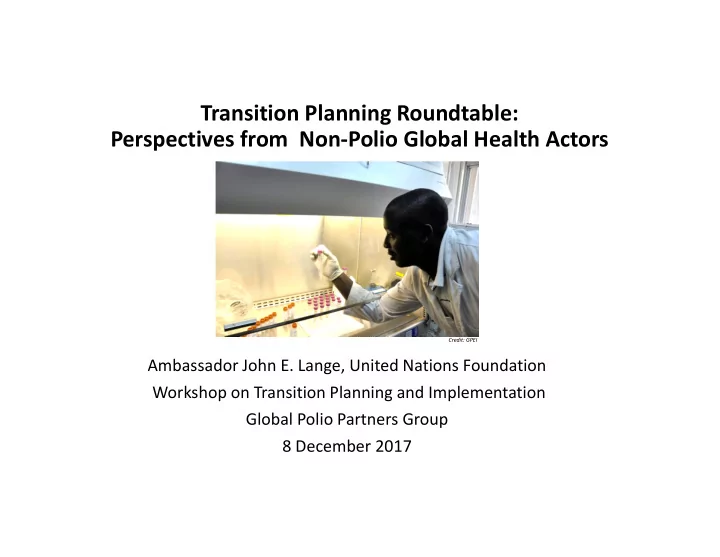

Transition Planning Roundtable: Perspectives from Non-Polio Global Health Actors Credit: GPEI Ambassador John E. Lange, United Nations Foundation Workshop on Transition Planning and Implementation Global Polio Partners Group 8 December 2017
Polio and other global health programs: “On average, 25% to 50% of staff funded through the GPEI spend time on non-polio activities such as routine immunization, disease surveillance, laboratory testing, and responding to public health emergencies; some countries’ health systems have been heavily dependent on polio funding for decades” Report of Transition Independent Monitoring Board, July 2017
Synergies with other international efforts (1): • Draft WHO Thirteenth General Program of Work (2019-2023): o Universal Health Coverage: � Essential health services (including full child immunization, health-seeking behavior for child illness, and health security: compliance with the International Health Regulations) o Health priorities: � Reduce rate of under five child deaths by 30% � Eradicate polio: zero cases of poliomyelitis caused by wild poliovirus or circulating vaccine derived poliovirus o Health emergencies
Synergies with other international efforts (2): • WHO Health Emergencies Program: o Strengthen national capacity to address health emergencies, including countries facing transition and health emergencies o Opportunity for integration with humanitarian sector o Ability to access hard-to-reach, border, migrant, refugee populations • International Health Regulations: o Commitment by 196 States-Parties to prevent, protect against, control, and provide a public health response to international spread of disease o Wild polio virus reconfirmed to be a Public Health Emergency of International Concern in Nov 2016 o In 2014, less than 1/3 of reporting countries (64) noted full achievement of IHR capacities
Synergies with other international efforts (3): • Global Health Security Agenda: o 7 of 11 action package/technical areas directly relevant to polio infrastructure o 9 of 16 GHSA members are polio transition priority countries • Related health initiatives include: o Immunization (routine immunization, measles and rubella, other vaccines) o Infectious diseases (HIV, TB, malaria, etc) o Child health o Water, sanitation and hygiene o Health data/surveillance o Human resources for health
Example: polio contributions to global health security Prevent • Immunization • In 16 focus countries, polio staff often largest source of immunization support • Following 2016 discovery of WPV in Nigeria, Lake Chad region immunized 116 million children across 13 countries in days Detect • Surveillance • Unprecedented capacity to detect VPDs and (laboratory, other emerging pathogens environmental, • Global Polio Laboratory Network in 92 countries community) Respond • Outbreak response • Malaria response in Nigeria (2017) • Emergency • Plague response in Madagascar (2017) Operations Centers • Earthquake response in Nepal (2015) • Ebola response in Nigeria (2014) • Flood response in Pakistan (2010)
Considerations for discussion: • To ensure a polio-free world, how can we help situate the Post-Certification Strategy within broader public health regulations, frameworks and programs? • How can we generate more documentation, analysis and action around practical implications, opportunities and challenges of polio transition at country-level? • Should we promote a coordinated approach to relevant country assessments (polio transition planning, Joint External Evaluations (JEEs), WHE assessments, etc.)? • How can we better engage other global health initiatives regarding the potential impact of GPEI winddown on their planning, budgeting and programming efforts? o Global Vaccine Action Plan, Gavi, WHO Regional Committee meetings, GHSA Ministerial meetings, JEE Alliance meetings, regional laboratory networks, etc. • What is the best way to engage donors and national governments to address gaps identified by countries through transition planning? • How can we maximize the contributions and insights of NGO/CSO partners working in relevant areas (advocacy and programmatic)? • What is the role of the private sector and public-private partnerships in polio transition?
Recommend
More recommend